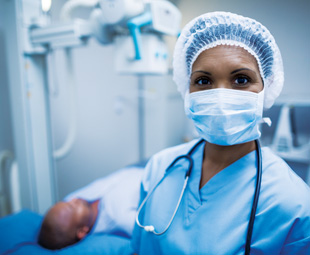Why public hospitals are losing the health battle

Despite both public and private hospitals being required to conform to the National Core Standards and needing to be audited, private hospitals seem to continually outperform public hospitals. MARISKA MORRIS finds out why
The majority of South Africans depend on the public healthcare sector. However, the service provided by public hospitals seems to be lacking compared to private hospitals, especially regarding cleanliness, even though both private and public hospitals need to comply with the same standards.
The government spends more than eight percent of the gross domestic product (GDP) on health, which is more than the five percent recommended by the World Health Organisation (WHO). The health department was allocated R38,5 billion for 2016/17 and R145 billion in 2014/15.
According to a paper written by Dr Marjorie Jobson, and published by the Khulumani Support Group in 2015, private hospitals spend around R120 billion annually, which is supplied from the more than
110 registered medical schemes and 3,4-million principal members.
All healthcare facilities need to comply with the National Core Standards, the Occupational Health and Safety (OHS) Amendment Act of 1993, as well as the National Health Amendment Act 12 of 2013.
 There are bodies that audit both private and public health facilities. The Office of Health Standards Compliance (OHSC) is responsible for auditing public hospitals throughout South Africa to determine their compliance with the National Core Standards.
There are bodies that audit both private and public health facilities. The Office of Health Standards Compliance (OHSC) is responsible for auditing public hospitals throughout South Africa to determine their compliance with the National Core Standards.
Many private hospitals are audited by companies such as the Council for Health Service Accreditation of Southern Africa (COHSASA) – a non-profit organisation that assists a wide range of healthcare facilities in Africa, including private hospitals in South Africa, to meet and maintain quality standards. COHSASA is the only African health facility accredited by the International Society for Quality in Health Care.
Despite this, the OHSC’s 2015/16 National Core Standards Inspectorate Annual Report found that (among other things) cleanliness is a big concern in public hospitals. The OHSC inspected health establishments across all nine provinces including four central hospitals, 11 provincial tertiary hospitals, nine regional hospitals, 27 district hospitals and 567 clinics for its report.
“Of major concern is the basic cleanliness of hospitals, which does not cover only the physical cleanliness, but also the availability of cleaning materials. Not a single central hospital scored above 70 percent,” the report states. Cleanliness in hospitals and clinics is especially important as a dirty environment could lead to the spread of disease and infections.
The worst-performing central hospital, among those that were reviewed, was the Dr George Mukhani Hospital in Pretoria near the township of Ga-Rankuwa, which only scored 47 percent in cleanliness.
Provincial tertiary hospitals were also plagued by poor cleanliness. Pelonomi Academic Hospital in Bloemfontein scored only 34 percent in cleanliness, followed by Dihlabeng Hospital with 38 percent.
Clinics in Limpopo scored a shocking 28 percent in the overall clinics score by province with Eastern Cape clinics scoring 30 percent. Gauteng was the only province to score more than 50 percent for the cleanliness of its clinics, at 55 percent.
 The reason for the cleanliness of hospitals in the private sector could be because they are subjected to scrutiny. This is noted in a 2016 report by Scenarium Group. It states: “The private sector is generally regarded to be “hospicentric”. In addition, the hospital sector is subject to scrutiny, due to the level of market concentration.”
The reason for the cleanliness of hospitals in the private sector could be because they are subjected to scrutiny. This is noted in a 2016 report by Scenarium Group. It states: “The private sector is generally regarded to be “hospicentric”. In addition, the hospital sector is subject to scrutiny, due to the level of market concentration.”
The understaffed, over-populated nature of public healthcare facilities also contributes to the difference in scores. Jobson notes: “The public sector is further hampered by a shortage of key medical personnel.”
According to the Health Professions Council of South Africa there are 70 575 registered emergency-care practitioners in South Africa. Jobson points out that in the public sector there is one doctor per 4 219 people, compared to one doctor per 243 patients in the private sector.
She also notes in her paper that there are 4 200 public health facilities in South Africa. Each clinic (that forms part of these facilities) provides services to an average of 13 718 people, which exceeds the WHO guidelines of 10 000 per clinic.
The higher standards of cleanliness in private hospitals compared to public hospitals can also be attributed to the quality-improvement programmes provided to private hospitals.
“COHSASA’s private sector clients – including Mediclinic, which has 37 of its hospitals in the COHSASA quality-improvement and accreditation programme – have well-entrenched health and safety standards. Furthermore, their enterprise-wide risk-management systems are well executed,” says COHSASA CEO Jacqui Stewart.
“The private hospitals that we work with must comply with the COHSASA standards on the implementation of health and safety systems as required by the Occupational Health and Safety Act. This includes the provision of fully fledged occupational health services, often rendered by a contracted company such as INCON,” Stewart adds.
To improve quality standards, Stewart advises that hospitals should offer proper training and orientation for personnel and should assess themselves against requirements set by the OHS Act and National Core Standards.
“Systems to comply with these requirements should form part of the organisational processes and form part of the day-to-day operation of facilities. Improvements in health and safety systems can also be effected by employing appropriately qualified occupational health practitioners, or outsourcing the service to accredited service providers,”
Stewart concludes.
Unfortunately, despite government’s high relative spend on public healthcare, this might prove easier said than done when taking into account the poor state of South Africa’s public healthcare system…



